The most flavorful tomatoes cannot be attributed to one single factor. It’s not just the seed variety or the vine-ripening that makes homegrown fruits taste the best. The amount of sunshine, consistency of water, and quality of the soil all have major impacts on the taste of the fruit. If your tomatoes lack flavor and sweetness, you may need to fix the growing conditions and maintenance.
Through six years of commercial organic farming, I grew thousands of pounds of farm-fresh, vine-ripened tomatoes. What sets richly-flavored homegrown fruits apart from the cardboard-flavored grocery store tomatoes? Let’s dig into 13 industry secrets for the sweetest tomatoes possible.
How Do You Grow the Sweetest Tomatoes?
The sweetest tomatoes are ripened on the vine, enjoyed at room temperature, and grown from healthy plants. A concentration of sugars and flavors in the fruit ultimately results from how you treat the plant.
Healthy tomato plants require full sunlight, consistent moisture, and balanced fertilizer to thrive. Be sure to choose the best variety for your culinary preferences and take the time to tend your garden for the most prolific, delicious yields.
13 Tips for Sweet, Flavorful Tomatoes
When you are a beginner gardener, sometimes your homegrown vegetables can’t quite compete with store-bought quality. But tomatoes are almost always the exception! It’s common knowledge that supermarket tomatoes majorly lack in flavor. They have been harvested green, exposed to ethylene gas in storage, and transported thousands of miles before they arrive on the supermarket shelves. They may have the appearance and texture of a tomato, but their aroma, sweetness, and flavor can be completely absent.
People flock to farmer’s markets and garden stands to enjoy homegrown tomatoes because they are rich with flavor, sweetness, and depth. Contrary to popular belief, this major difference in taste is not just attributed to vine-ripening. There are many secrets and false rumors on how to grow incredible tomatoes, but here are 13 reliable tips from experts to help you grow the sweetest fruits possible.
Choose the Best Varieties
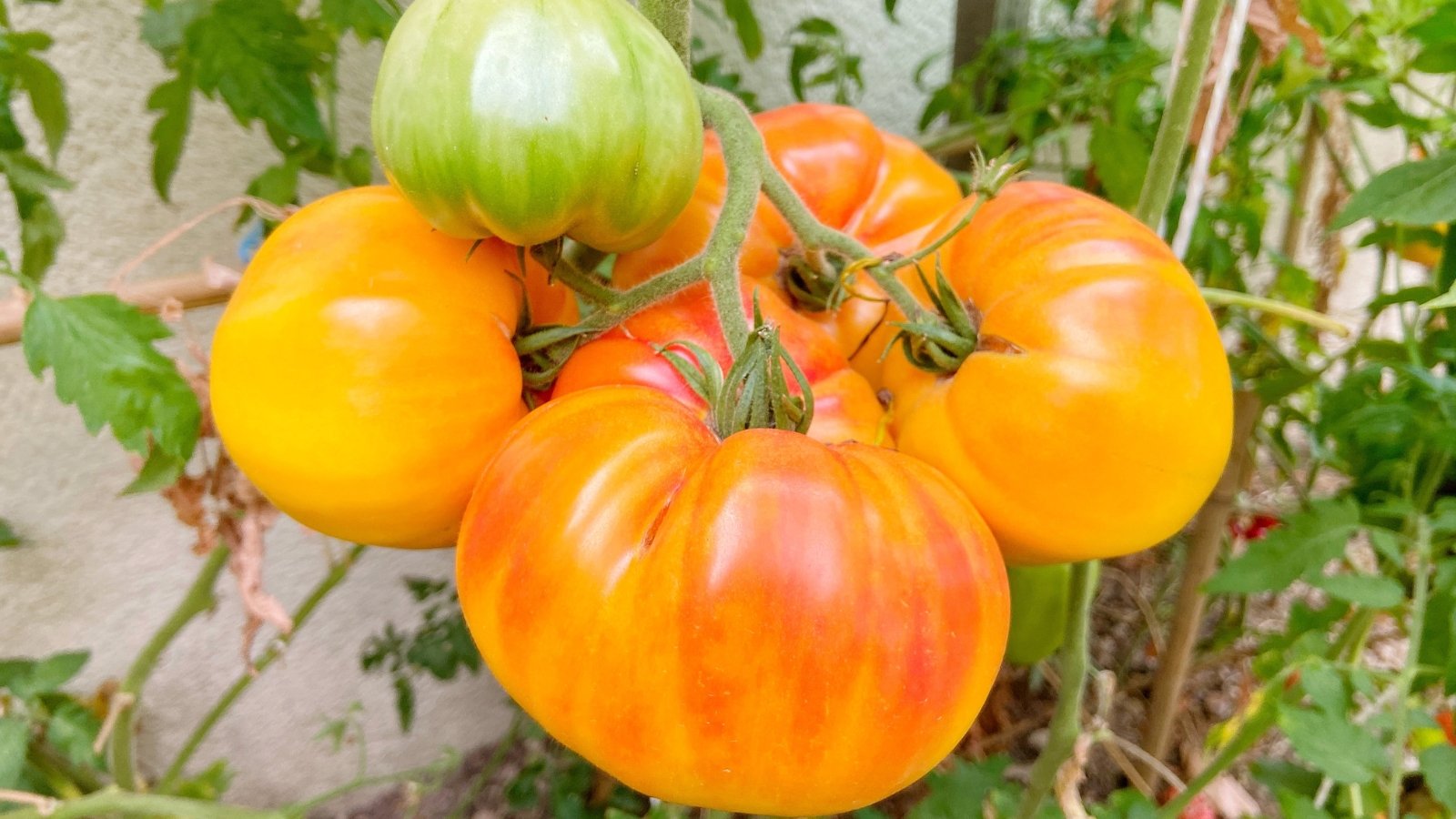
Like all living things, the genetics of a plant determine what they will grow. You wouldn’t expect a chihuahua puppy to grow into a full-size Great Dane, and you can’t expect a paste tomato variety to yield extraordinarily sweet fruits. Different vegetable varieties are bred for unique uses in the garden and kitchen. The sweetest tomatoes come from cherry and slicer varieties that are bred for high sugar concentration in the fruits.
Don’t worry; this doesn’t mean you need a Frankenstein tomato. Traditional plant breeding or hybridization does not come from genetic modification or GMOs. Instead, these ultra-sweet seed varieties are cross-pollinated and selected over time. It’s helpful to think of seed varieties like dog breeds. An Australian Shepherd is bred to herd sheep, and a ‘Pineapple Pole’ tomato is bred for its tangy-sweet fruity flavor in an orange beefsteak fruit.
Indeterminate vs. Determinate
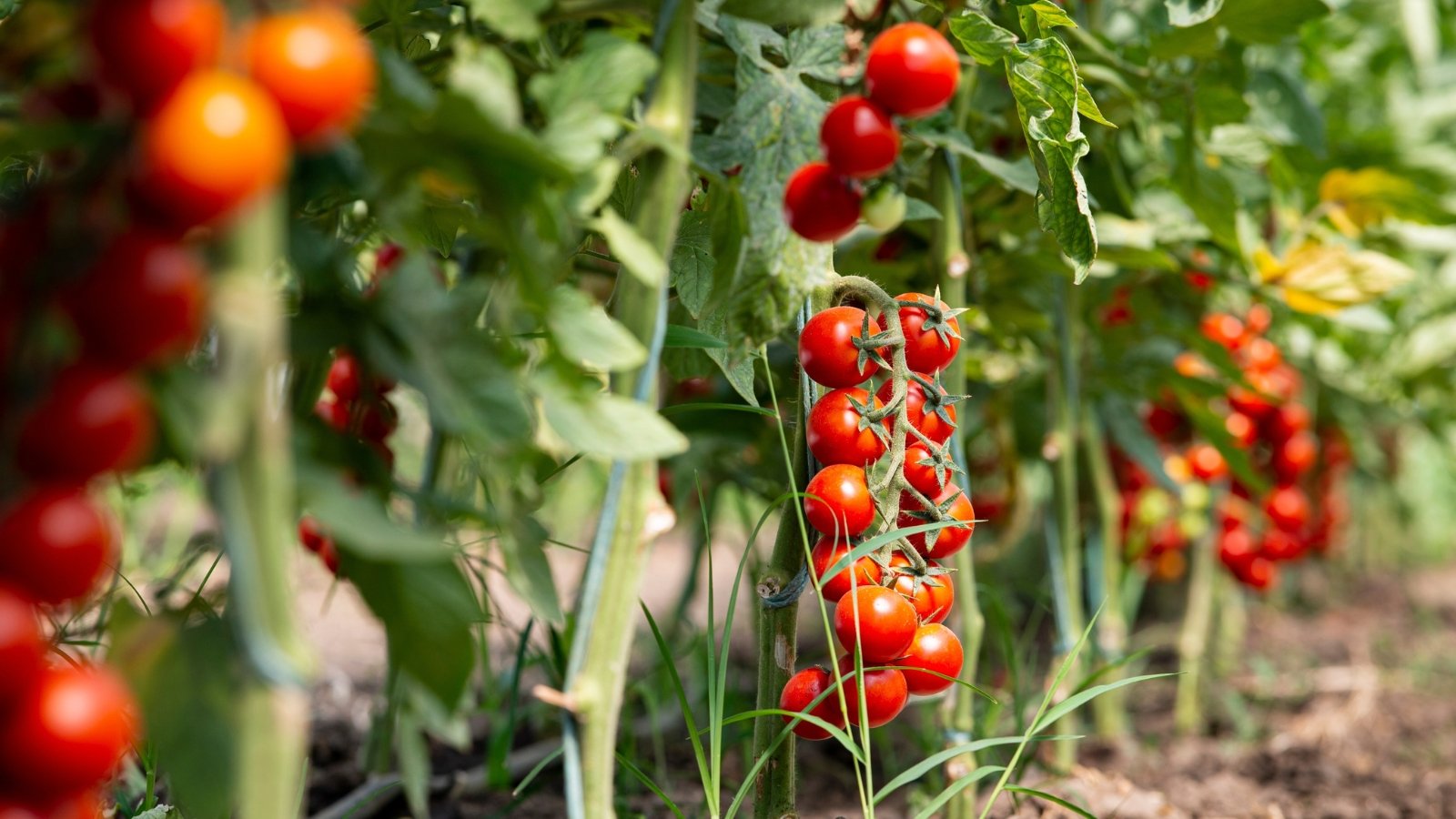
Before choosing your tomato variety, consider how you want it to grow. Vining, or indeterminate types, require a trellis to ramble upward. They are great for raised beds because they can yield abundantly by taking advantage of vertical growth. Vining types also provide continuous yields throughout the season, making them ideal for fresh snacking and recipes.
Bush, or determinate types, are stouter and shrubby, great for containers and small spaces. They often still require a tomato cage for support. These types yield all of their fruit in one or two concentrated flushes, which is better for canning or preservation.
Cherries vs. Slicers
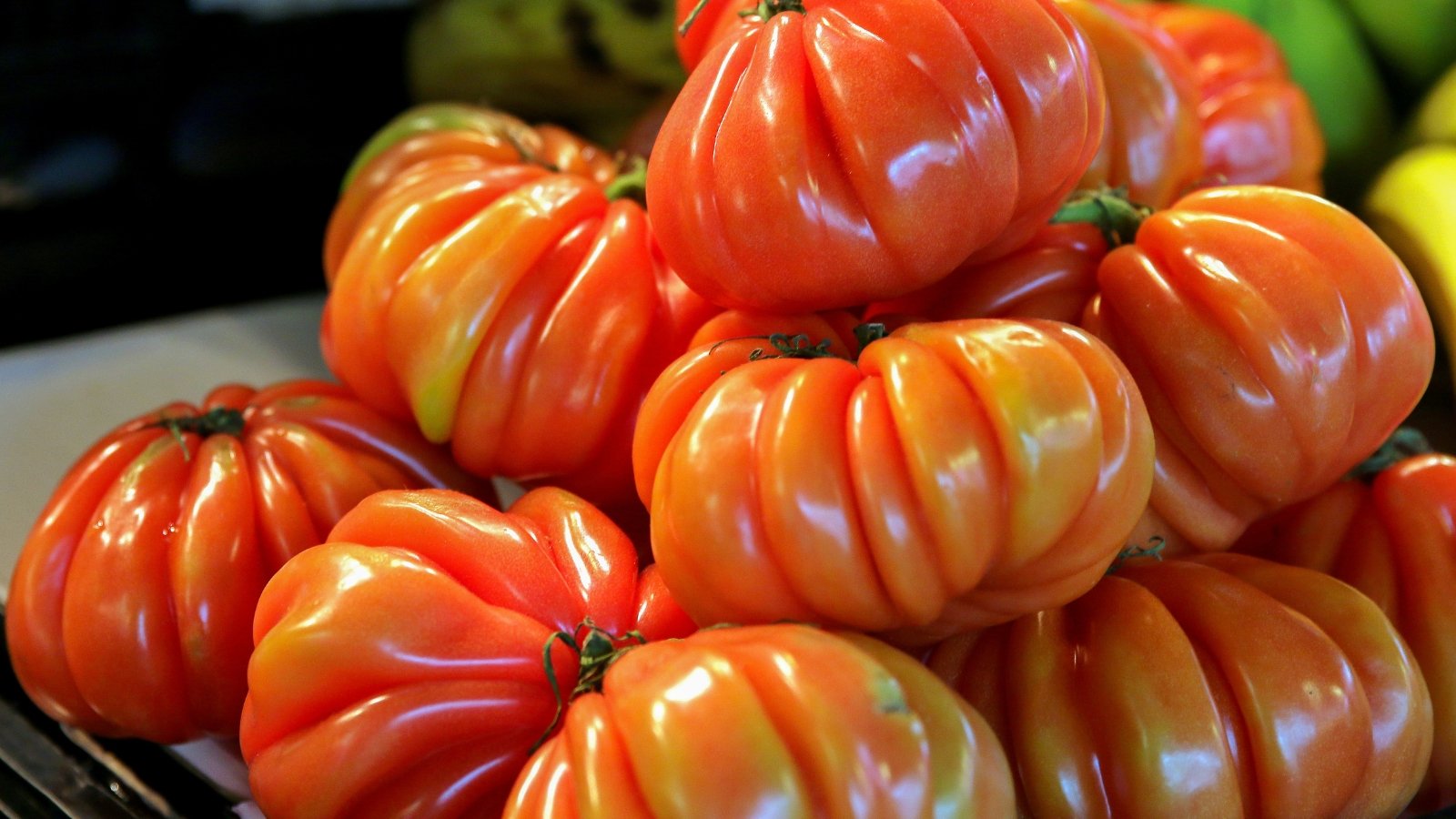
Generally, cherry tomatoes are the sweetest, and slicers are the most flavorful. Cherries are small, two to three inch spherical fruits bred for snacking fresh off the vine. They are great for salads, salsas, and roasting, but many gardeners enjoy them straight off the vine.
Cherries have the greatest accumulation of sugars that burst into your mouth when you bite into them. These juicy little snacks have ultra-high Brix ratings (up to 10.5). Brix is a measure of dissolved sugar content in a plant. In the case of ‘Sun Gold,’ the fruits are about 9.3% sugar.
The sweetest cherry tomato varieties include:
- ‘Sun Gold:’ This iconic, ultra-sweet orange cherry grows on a vining plant.
- ‘Chocolate Cherry:’ Dark-hued fruits do not taste like chocolate but are decadently sweet.
- ‘Gardener’s Delight:’ This 1950s German heirloom has extra sweet fruits on vigorous vines.
- ‘Artisan Bumble Bee Blend’: Enjoy a medley of pink, purple, and yellow-striped sweet fruits with a tangy zest.
While cherries are usually the sweetest, slicers have the most complex flavor. They include richer profiles of acidity, tanginess, fruitiness, and savory tastes with a meatier texture. The slicer category includes any large-fruited variety, such as beefsteaks and most heirlooms. These are best for sandwiches, burgers, caprese, and anywhere you need a large, thick slice.
The most flavorful slicers include:
- ‘Cherokee Purple:’ Among the most popular heirlooms, this variety regularly wins taste trials for its balance of sweetness and smokiness.
- ‘Oxheart:’ These unique heart-shaped heirlooms are dense and flavorful for roasting.
- ‘Brandywine Blend’: This medley of red and yellow fruits can reach up to two pounds each with well-balanced, classic tomato flavor.
- ‘Ace 55’: This bush tomato has a classic fresh flavor and low acid content.
I recommend experimenting to find your favorite cultivars. You can grow several different types in your garden! Unlike corn and squash, you don’t have to worry as much about cross-pollination because the plants usually self-pollinate.
Ripen (Mostly) on the Vine
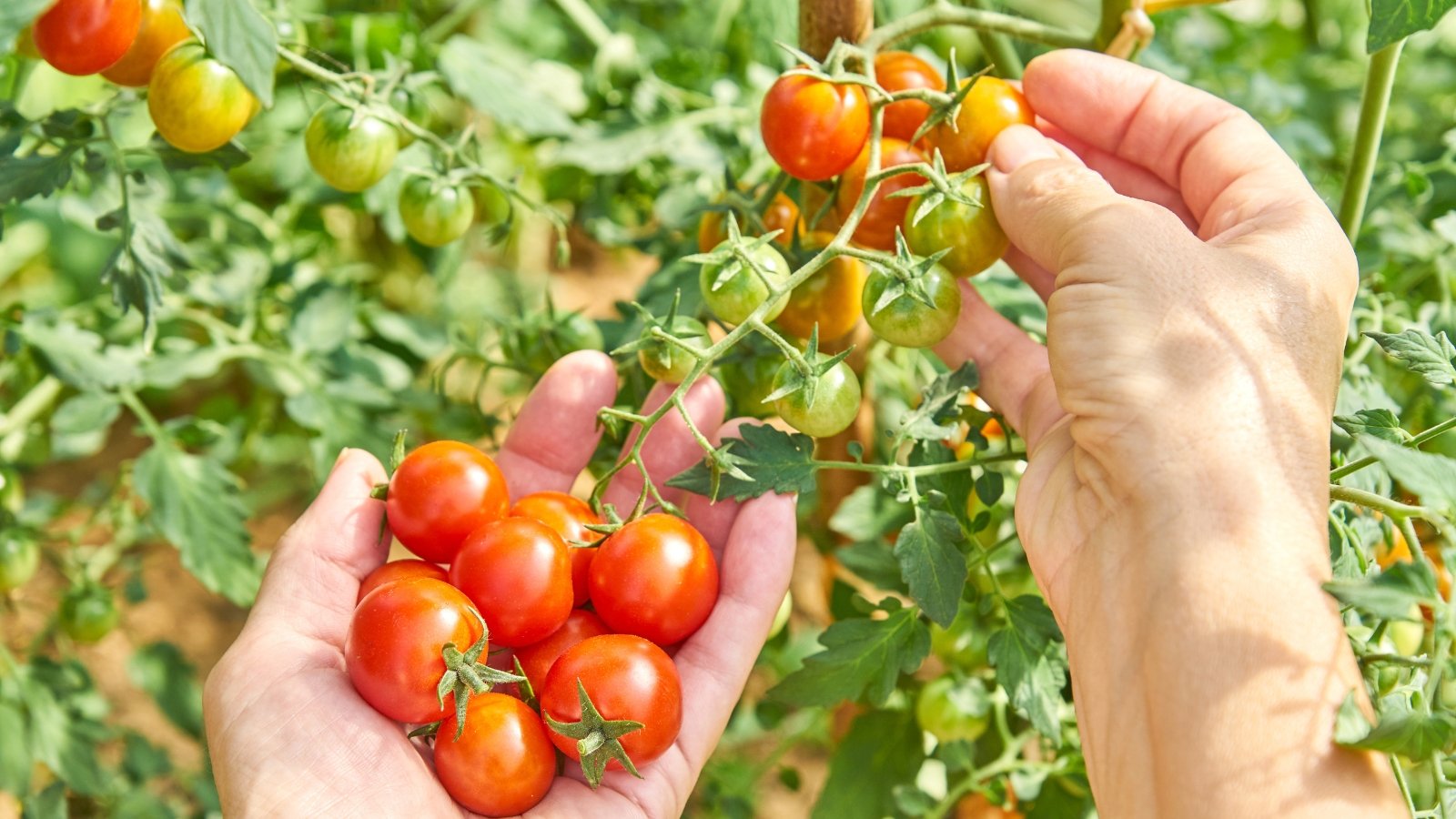
Vine-ripening is a well-known secret to flavorful tomatoes. Supermarket fruits are harvested green because they usually need to be transported and stored for long periods. The fruits are then treated with ethylene gas (a plant ripening hormone) before they are placed on shelves. Because they don’t get to ripen on the plant, these fruits typically lack flavor.
In the garden, it’s obviously best to leave your fruits on the plant until they are ready to harvest. This ensures that the fruits receive all the sugary energy they need from the vine. Research even shows that tomatoes ripened on-the-vine have more lycopene and carotene nutrients than those harvested before the “color break” stage.
The “breaker” stage is right when the fruits begin to change color. Tomatoes ripen from the bottom up. The upper parts of the fruit may still appear green, but as long as the bottom has changed color or “blushed,” the fruit has already started producing ethylene. At this point, they have concentrated the sugars and ripening hormones from the plant. They can safely be harvested and ripen the rest of the way on your countertop. As long as a tomato reaches the breaker stage, it is still considered to be vine-ripened.
It is a common misconception that you need to leave tomato fruits on the plant until they are fully red (or purple or orange). However, this can sometimes lead to over-ripening, causing a mushy texture and weird acidic flavor. For the ideal balance of sweetness and classic tomato essence, harvest the fruits when they are 50-70% ripe.
Plant in Full Sunshine
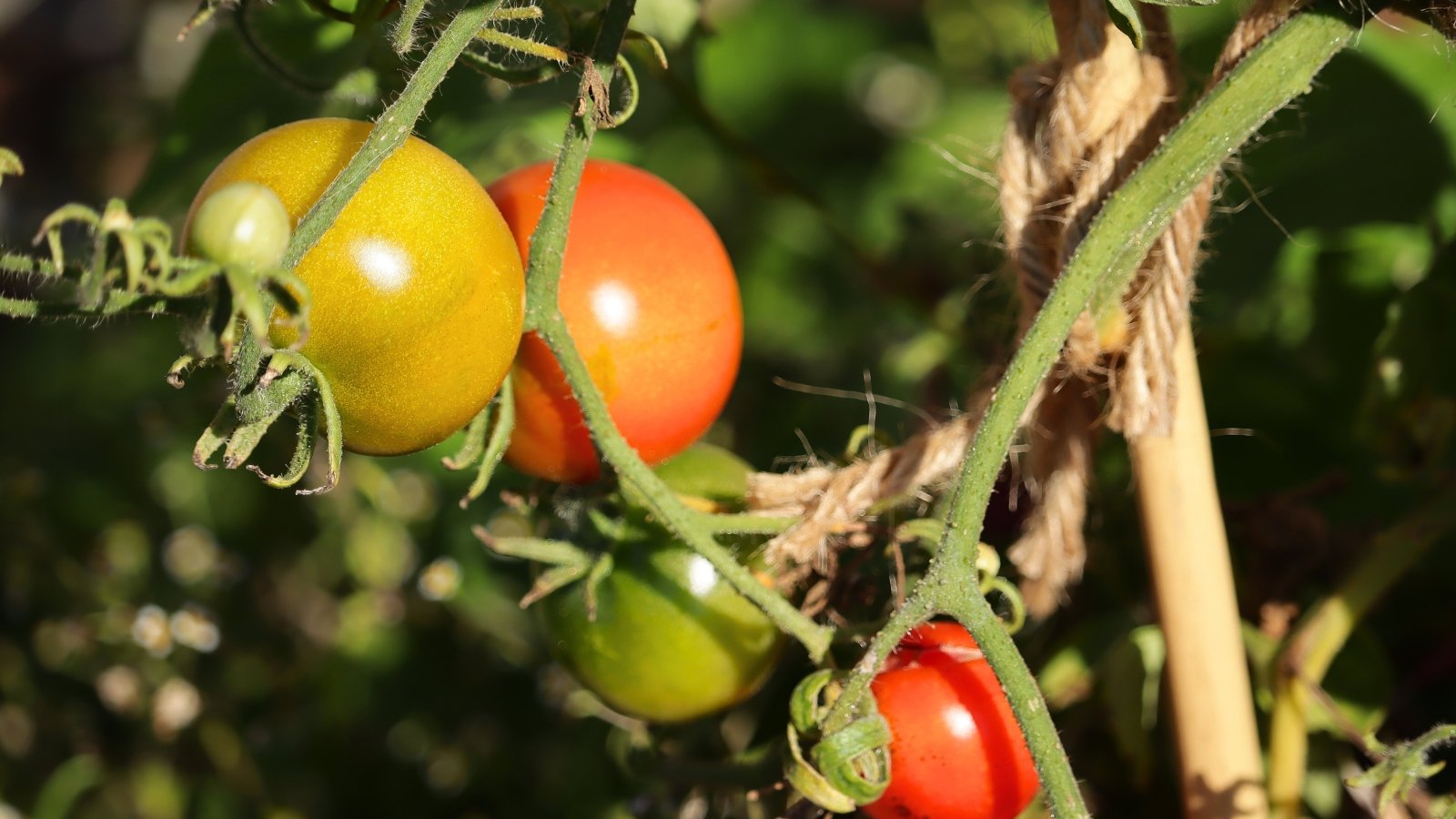
In the plant world, sunshine means sugar. Photosynthesis is the process of converting sunlight, water, and carbon dioxide into glucose. Plants use glucose to fuel all major growth functions, including fruit production. Without sufficient sunlight, plants cannot produce enough glucose to yield sweet, flavorful tomatoes.
Tomatoes need a minimum of six to eight hours of direct sunlight every day to thrive. Plants growing in the shade may have faded foliage, few flowers, and little to no fruit. In areas with partial sun, the plants may produce fruit, but it may not be as sweet and high quality as sun-grown tomatoes.
Tomatoes originated in hot, vibrant regions of Central and South America. These plants have adapted for thousands of years to bask in open sunshine. Without enough sunlight, the leaves will turn pale green or yellow. This happens because there isn’t enough light energy to fuel the production of chlorophyll, which is the green pigment inside leaves.
If you notice pale leaves, slow growth, and measly fruit production, light is probably an issue. An absence of yellow flowers is another key symptom of insufficient light. Without flowers, there won’t be any fruit!
Plant in the brightest part of your garden. South-facing beds are ideal because they receive the most amount of sunlight throughout the day. Southern growers can get away with east-facing beds that receive predominantly morning sun. The key is to keep tomato plants away from anything that can cast major shade. Your house, shed, fence, trees, shrubs, or neighboring buildings can cause big issues for tomatoes if they overshadow them for a large portion of the day.
Provide Consistent Moisture (Don’t Under or Over-Water)
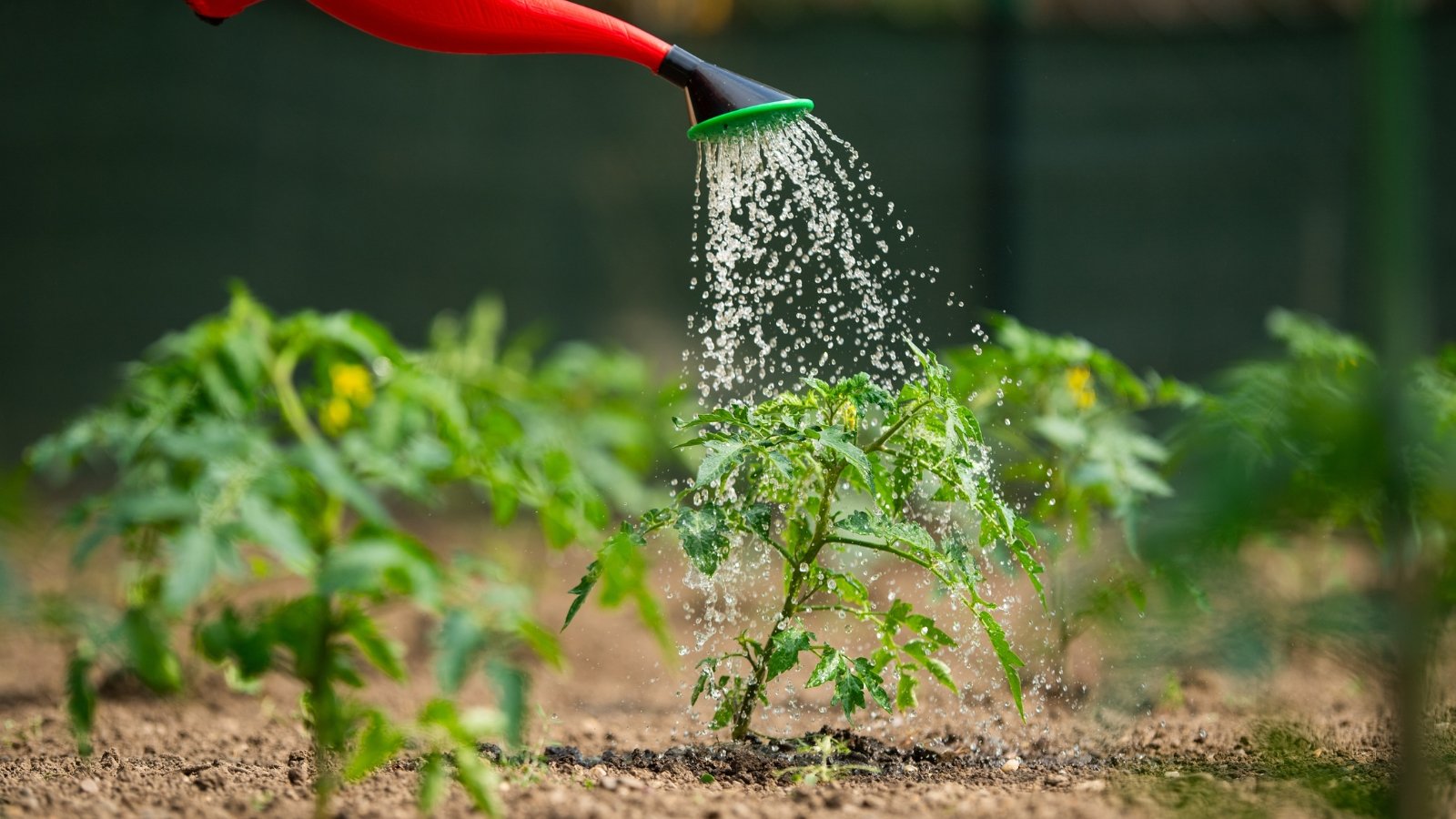
Consistent moisture is crucial for success with tomatoes. These plants do not like huge fluctuations in water. Dramatic shifts from ultra-wet to ultra-dry soil can cause problems with blossom end rot, fruit cracking, and wimpy growth. We all enjoy a little predictability, and your plants will be far less stressed if they have regular access to moist soil. Less stress means more energy to funnel into sweet fruits!
Ideally, the soil should always be close to the moisture level of a wrung-out sponge. Of course, small fluctuations are natural, and the upper layers of soil will dry out more quickly in hot weather. This is why deep watering is important.
Deep vs. Shallow Watering
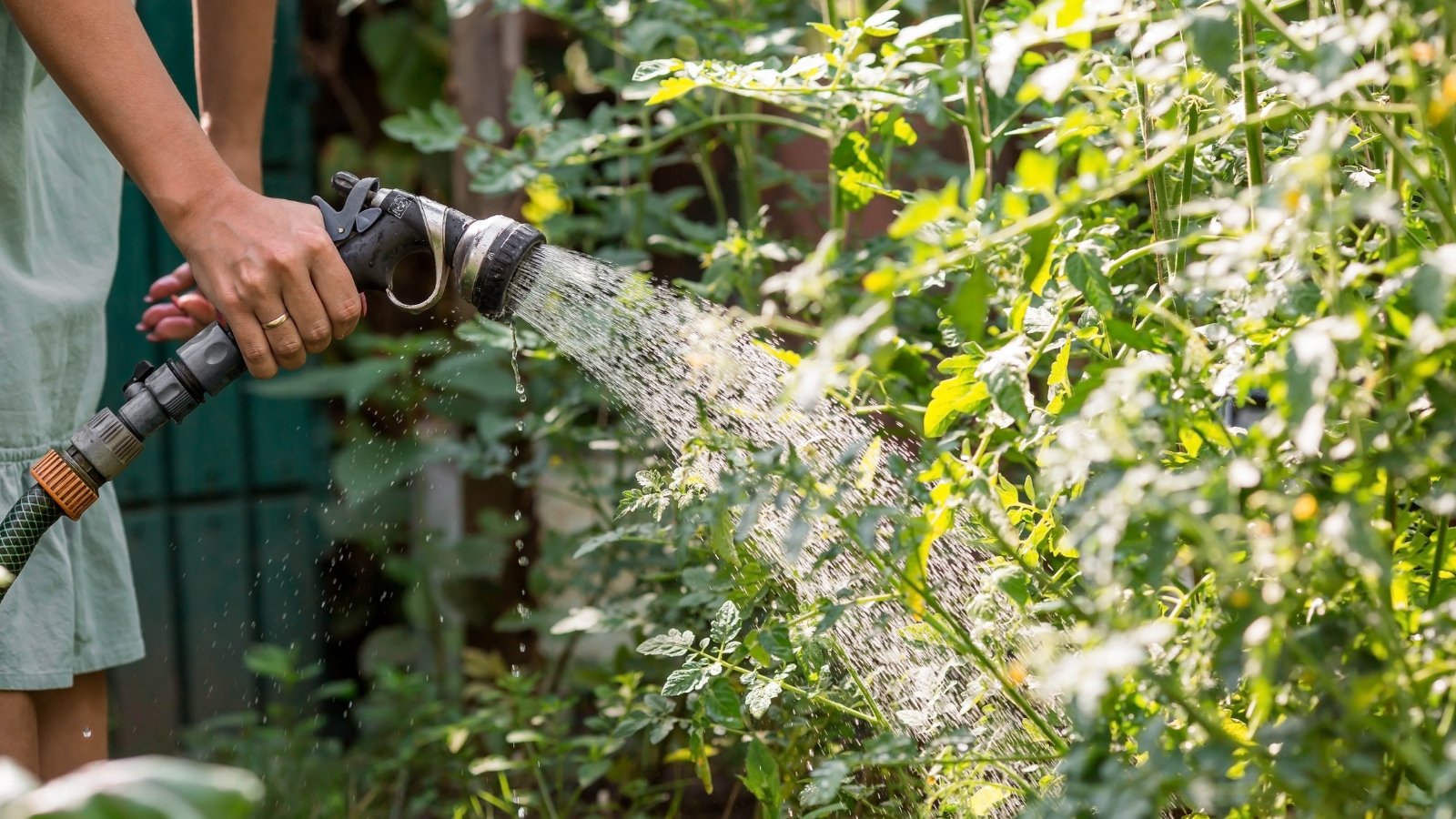
Deep watering means watering for longer but less frequently. In other words, you want to thoroughly saturate a tomato bed or container for several minutes to ensure the water trickles down 12-18 inches into the soil.
Many gardeners make the mistake of frequent, shallow watering, which only wets the upper few inches of soil. This can stunt the root systems and reduce overall yields down the line. You want their roots to reach deep into the soil and form robust webs of feeder roots to gather moisture and nutrients all season long.
Best Types of Irrigation

On average, a fruiting tomato plant needs one to two inches of water per week. Drip irrigation, soaker hoses, or olla clay pots are the ideal options for watering. Sprinklers and overhead irrigation are not recommended because they wet the leaves, raising the risk of foliar disease. Moreover, the majority of water from sprinklers evaporates in the sunlight or fails to soak the soil surface.
Consistently moist soil yields healthier plants and sweeter fruits because the vines will never face drought stress. You can run your irrigation system for about 30 minutes every few days, depending on the weather and conditions. Always check the soil before watering and stick your hand down to far enough to gauge the soil moisture at deeper levels. Compost-rich soil and mulch are very helpful for retaining moisture in the peak of summer.
Reduce Water Just Before Harvest
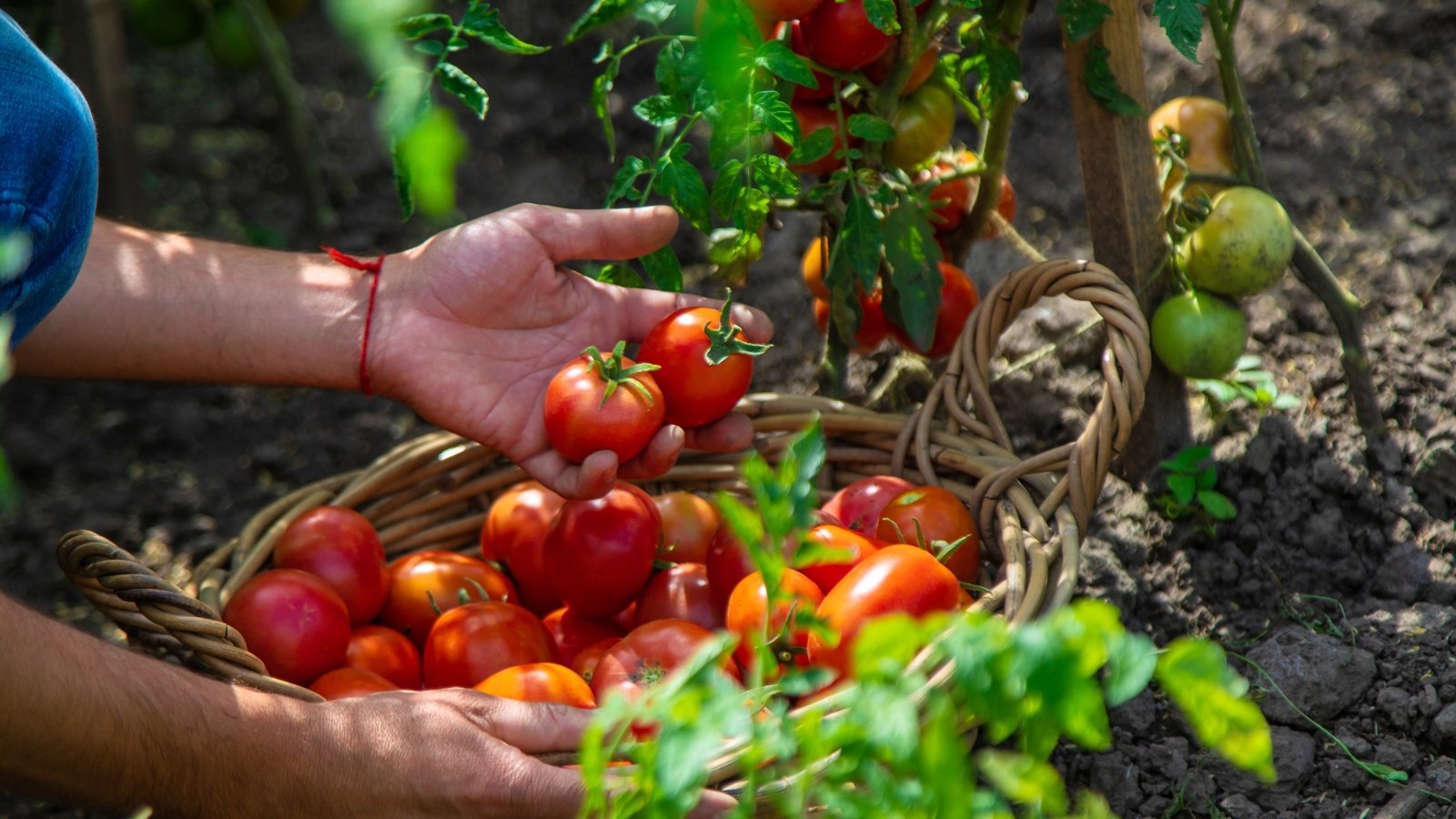
It is a common misconception that less water will yield sweeter tomatoes. This is only partially true. Your plants need plenty of consistent moisture throughout the majority of the growing season. Drought stress will dramatically reduce yields.
However, you can cut back on water in the few days leading up to a major harvest. This is called water deficit (WD), and it has been studied extensively in the scientific literature. A minor water deficit (about 50-60% water reduction) in the days before harvest is shown to enhance the sugars and reduce the acidity.
So, depending on the plant’s health and conditions, cutting back on water right before harvest may enhance the fruit’s sweetness and reduce the risk of cracking. You may notice that a major rainstorm can sometimes burst open fully ripened fruits that remain on the vine. This occurs because the cells become oversaturated with water, and they crack. While we cannot change the weather, we can avoid overwatering during the harvest phase.
If your plants have lots of “blushing” fruits that are starting to ripen on the vine, avoid watering for two to three days to promote a concentration of sugars. Tomatoes are normally about 95% water, depending on the variety and conditions. A slight reduction in irrigation can promote denser fruit with higher sugar content.
Remember, this does not mean you should stress your plants by dehydrating them for long periods of time, especially in hot weather. Water deficit is not recommended in the vegetative (leafy growth stage) of tomato development. The plants need plenty of water after transplanting and throughout their growth cycle to ensure they can produce lots of leaves and fruit later in the season.
Use a Balanced Fertilizer High in Potassium
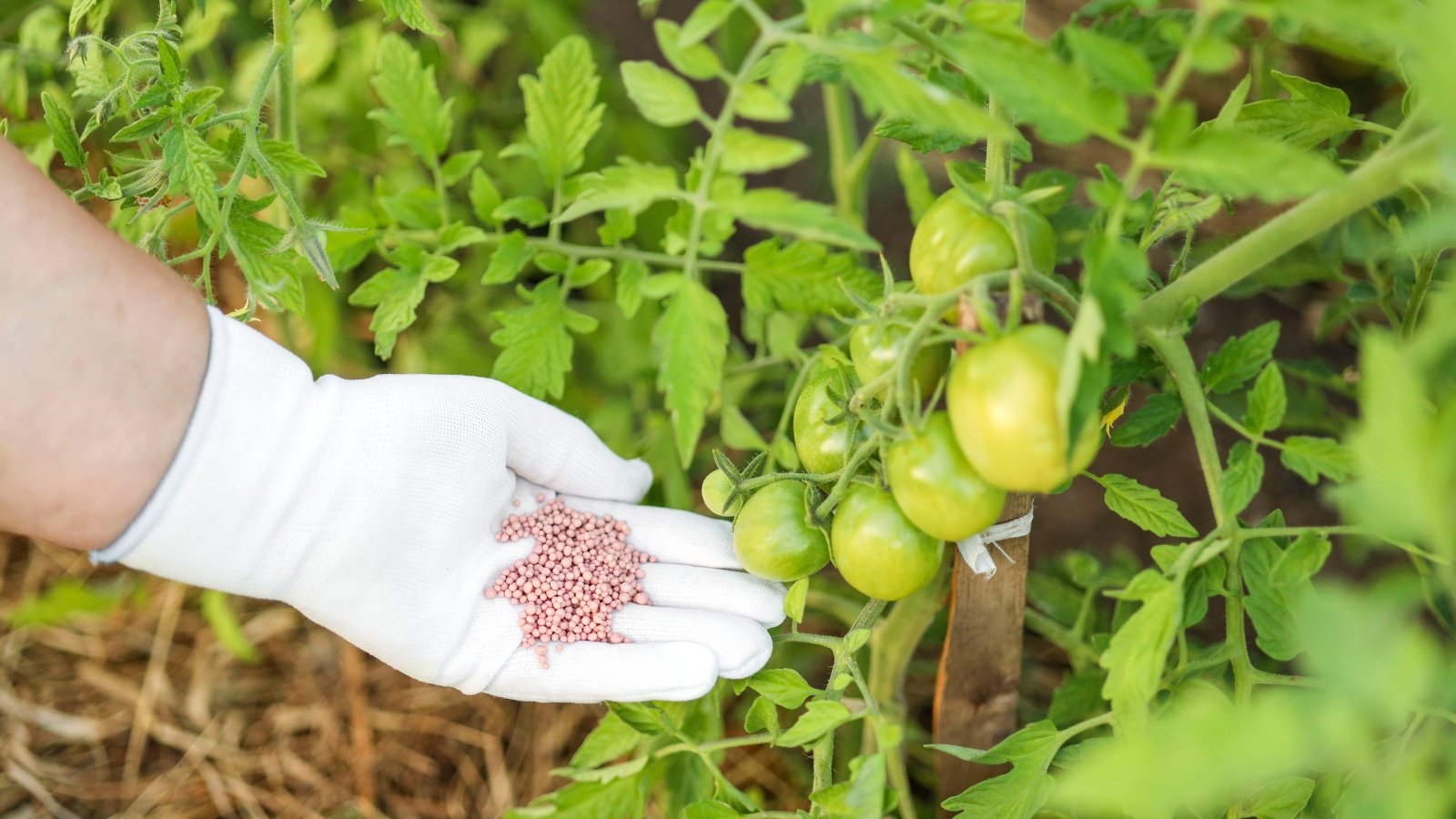
It’s a natural tendency to associate more fertilizer with better growth. However, you should be careful when fertilizing. The biggest, sweetest fruits do not come from the highest-fertilized plants. In fact, too much nitrogen fertilizer can cause an overgrowth of leaves and vines at the expense of fruit production. A moderate amount of balanced, slow-release fertilizer is far more important for sweet yields.
In general, synthetic quick-release fertilizers are not recommended for garden tomatoes, particularly if they have a high nitrogen content. They are not approved for organic growing, and they can sometimes cause more harm than good. The biggest risk with synthetic fertilizers is overfertilizing or nutrient-burning your plants, which can cause yellowing, browning, and death. In minor cases of excess nitrogen, plants become outrageously lush, with super dark green leaves and spindly, weak stems. This overgrowth leads to less flowers and less sweet fruits.
Balanced, slow-release fertilizers are much more ideal. They have NPK ratios that are close in number, such as 4-4-4 or 3-4-6. Fertilizers with less nitrogen and higher amounts of potassium are even more beneficial for tomato fruiting. Potassium is a vital nutrient that controls plant ripening. The amount of potassium determines the levels of sugars in the fruit. Soils deficient in potassium often lead to lower quality tomatoes.
Sources of Potassium
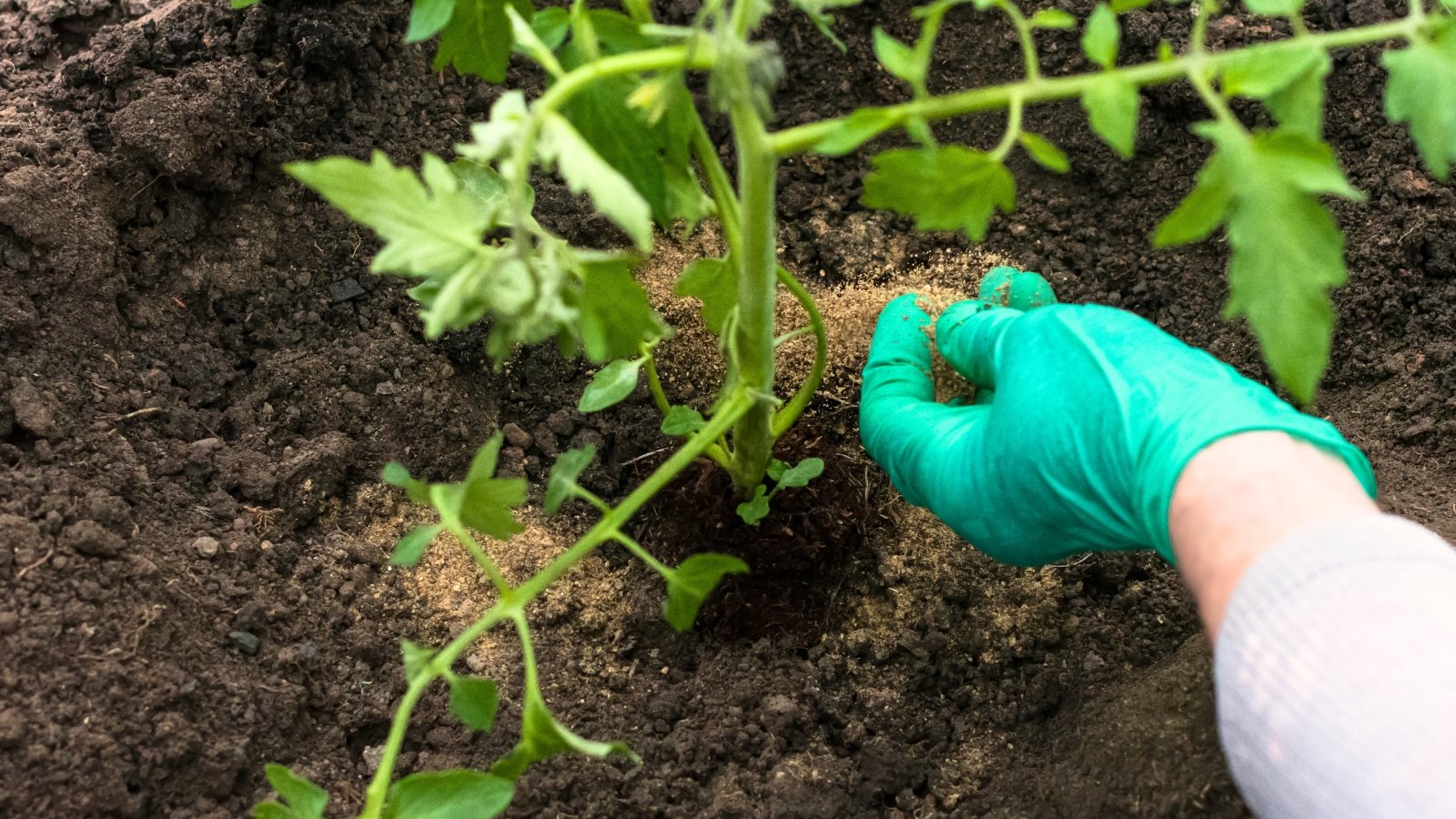
Wood ashes, compost, langbeinite, and kelp meal are great sources of potassium. Even better, try a specially-formulated blend for tomatoes, such as Espoma Tomato Tone. Slow-release organic fertilizers provide a continuous supply of nutrients to sustain plant growth throughout the season. The nutrients must be broken down by microbes before the plant can absorb them, which ensures that your plants don’t suffer from fertilizer burn.
It is also important to check the pH of your soil to ensure potassium is accessible to your plants. Tomatoes prefer a slightly acidic pH around 6.2 to 6.8. If the soil pH is too high or low on your annual soil test, you may need to adjust with limestone (to increase/alkalize the pH) or elemental sulfur (to decrease/acidify the pH).
Plant in Well-Drained Soil
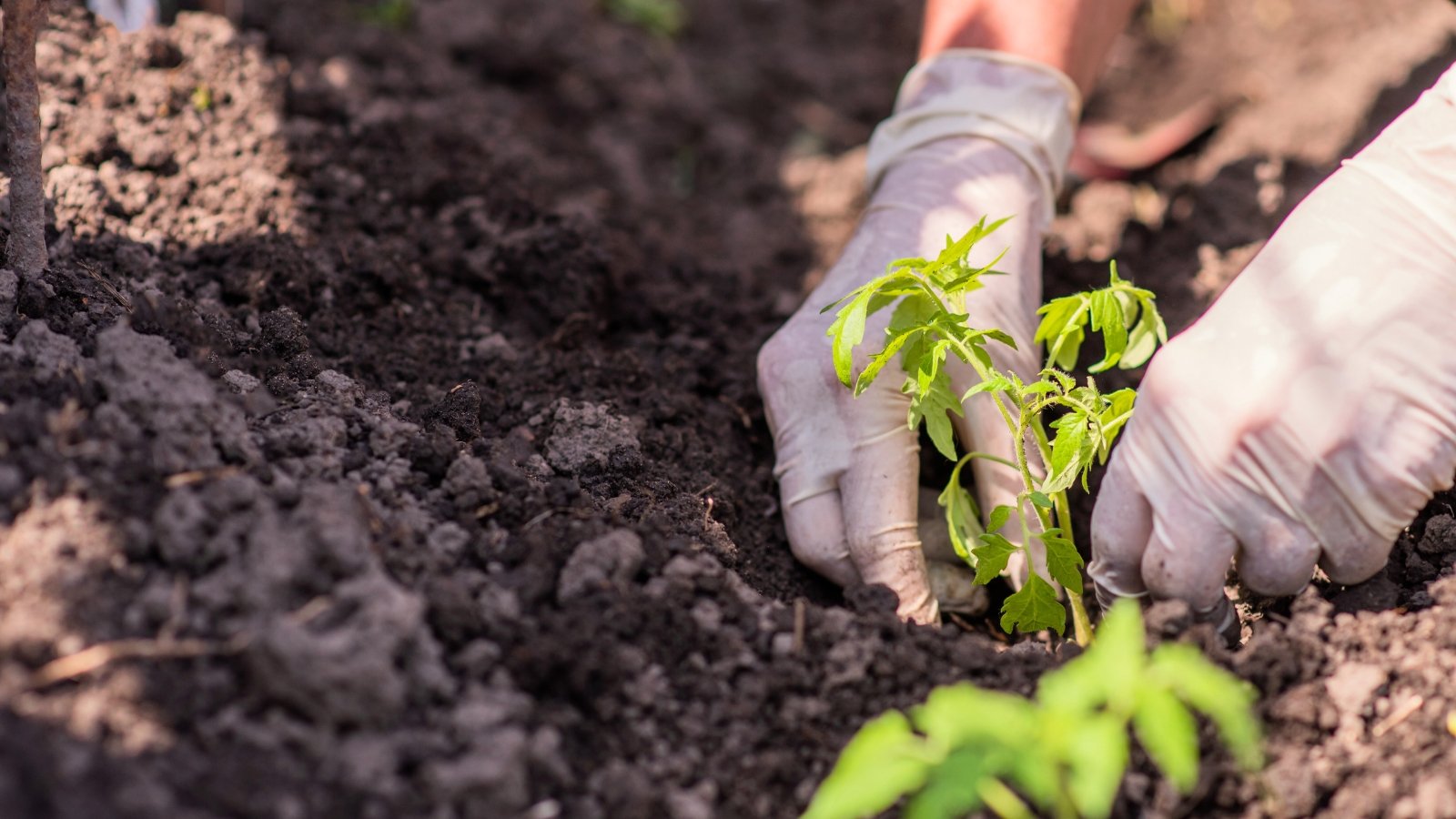
Like most garden crops, tomatoes dislike “wet feet.” They don’t want to sit in soggy soil. Drainage is key for keeping the plants healthy and disease-free. Heavy clay soil must be thoroughly loosened and amended with compost, leaf litter, peat moss, and/or drainage materials like vermiculite. Compacted soil should be loosened with a broad fork or digging fork to ensure that air and water can move freely between the soil particles.
If you are growing in containers or raised beds, fill them with a standard quality potting mix or your own blend. Ingredients like compost, rotted manure, peat moss, vermiculite, perlite, or coco coir are wonderful for tomatoes. These ingredients create a diversity of soil particle sizes to keep oxygen and water flowing through the soil profile. Stagnant, soggy soil can lead to a proliferation of anaerobic microorganisms, including pathogens like root rot fungi.
To check the drainage of the soil, pour a large amount of water from a hose or watering can over the soil surface. The water should drain almost immediately. If the water pools up on the surface, the soil may lack drainage. If it infiltrates quickly, this means that air and water can rapidly reach the lower layers. Remember, roots need to breathe too!
Soil drainage is really all about texture. While sunflowers and dandelions might grow from the hardest-packed clay, tomatoes are less likely to thrive in poorly textured ground. However, they also don’t want to grow in pure sand either. A balance of soil drainage and water retention is ideal. This is where compost comes into play.
Amend With Compost
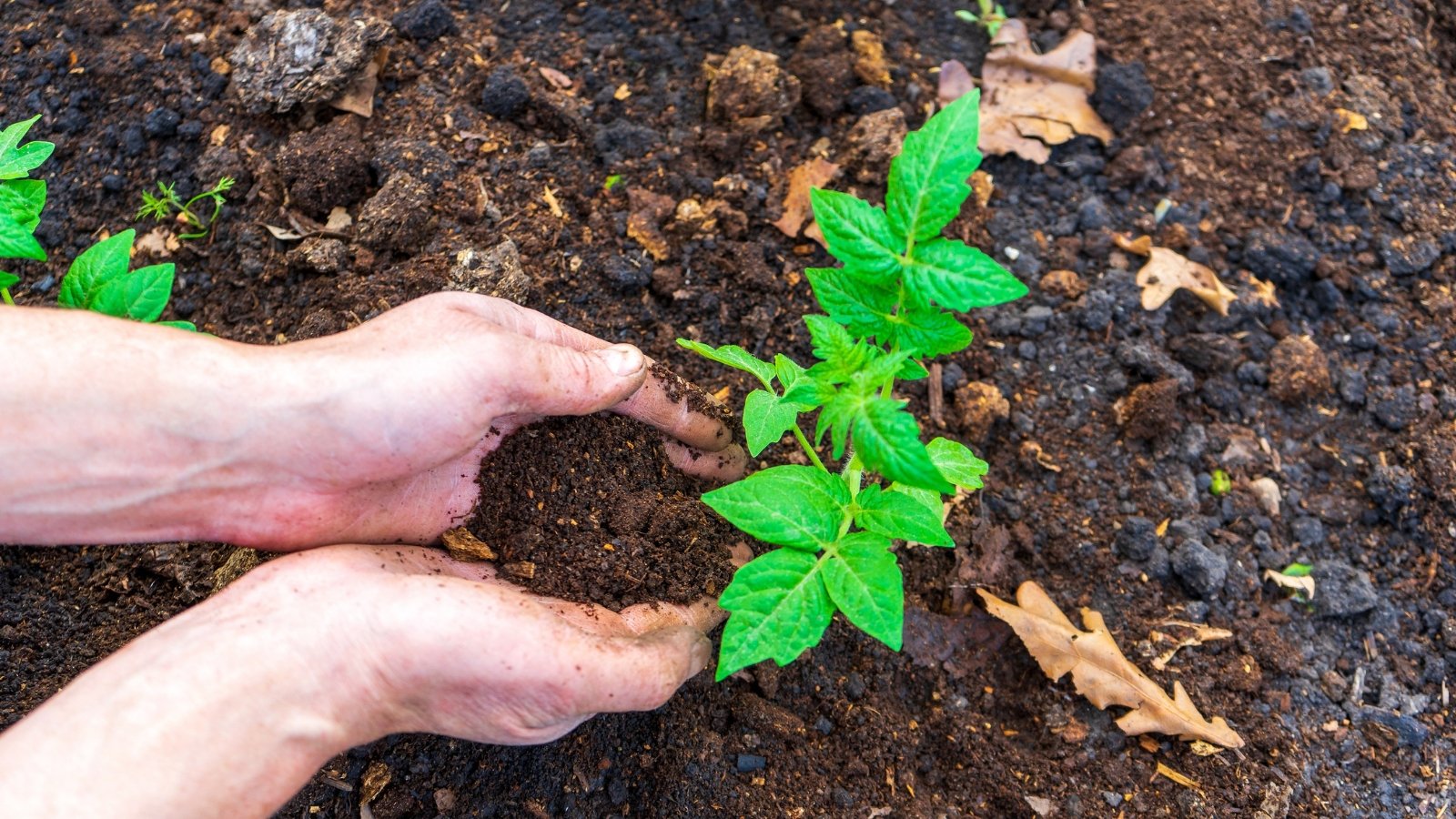
It may seem odd to correlate compost with tomato sweetness, but the link is very important. Compost is the richest source of organic material we have in our gardens. Properly heated, cooled, and aged compost offers a wealth of benefits to tomatoes, as well as most garden crops. Moreover, compost includes billions of beneficial microorganisms that help tomatoes absorb nutrients, fend off infections, and grow into the healthiest plants possible.
The intriguing thing about compost is its multi-functionality. It enhances soil texture, drainage, nutrient availability, microbial activity, and overall plant health. Compost improves soil drainage yet also improves water retention. It prevents soggy soil and also prevents drought stress. Better yet, compost can have higher levels of plant-available potassium, which is very important for sweet, flavorful tomatoes.
Tomatoes are often one of the most valuable garden crops, so don’t skimp on compost in these beds! Add one to three inches of compost at the beginning of the season before planting, and consider side dressing later in the season for an extra boost.
Compost can be used as a mulch-like layer over the surface or you can sift it into the soil with a digging fork. However, avoid chopping or churning your compost too much—the chunks (scientifically called “soil aggregates”) are important for soil and root health.
Use Mulch
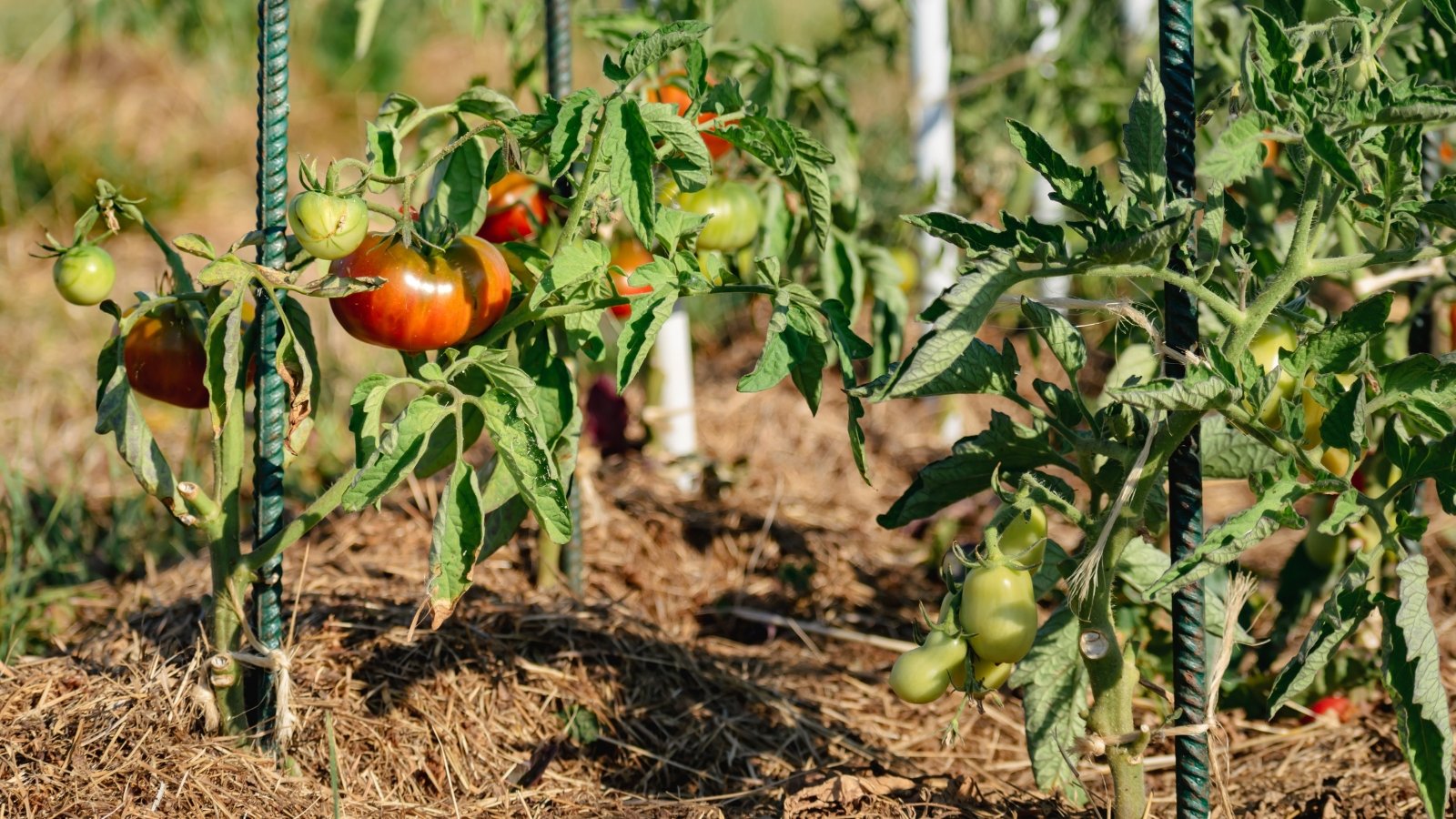
Mulch is one of the most underrated garden tools. In an ideal world, no garden soil would stay bare! If you think of soil as nature’s fragile skin, you can understand why she works so hard to cover it with ground cover, weeds, or layers of fallen leaves. As organic growers, we aim to mimic nature as much as possible. More flavorful tomatoes could be an added benefit!
The biggest benefit of mulching your tomatoes is enhancing water retention. We talked extensively about the importance of consistent moisture. In addition to compost, mulch is the secret sauce for conserving moisture throughout the summer. Shredded straw mulch or dried leaf litter are the best options for tomato beds. You can spread a two to three inch thick layer over the top of the soil surface to protect it from drying out and suppress weeds in the process.
Leave a little ring of space around the base of the tomato vines to allow them some room to breathe. If you are using drip lines or soaker hoses, run the irrigation underneath the mulch to ensure water reaches the soil directly.
Remove Suckers
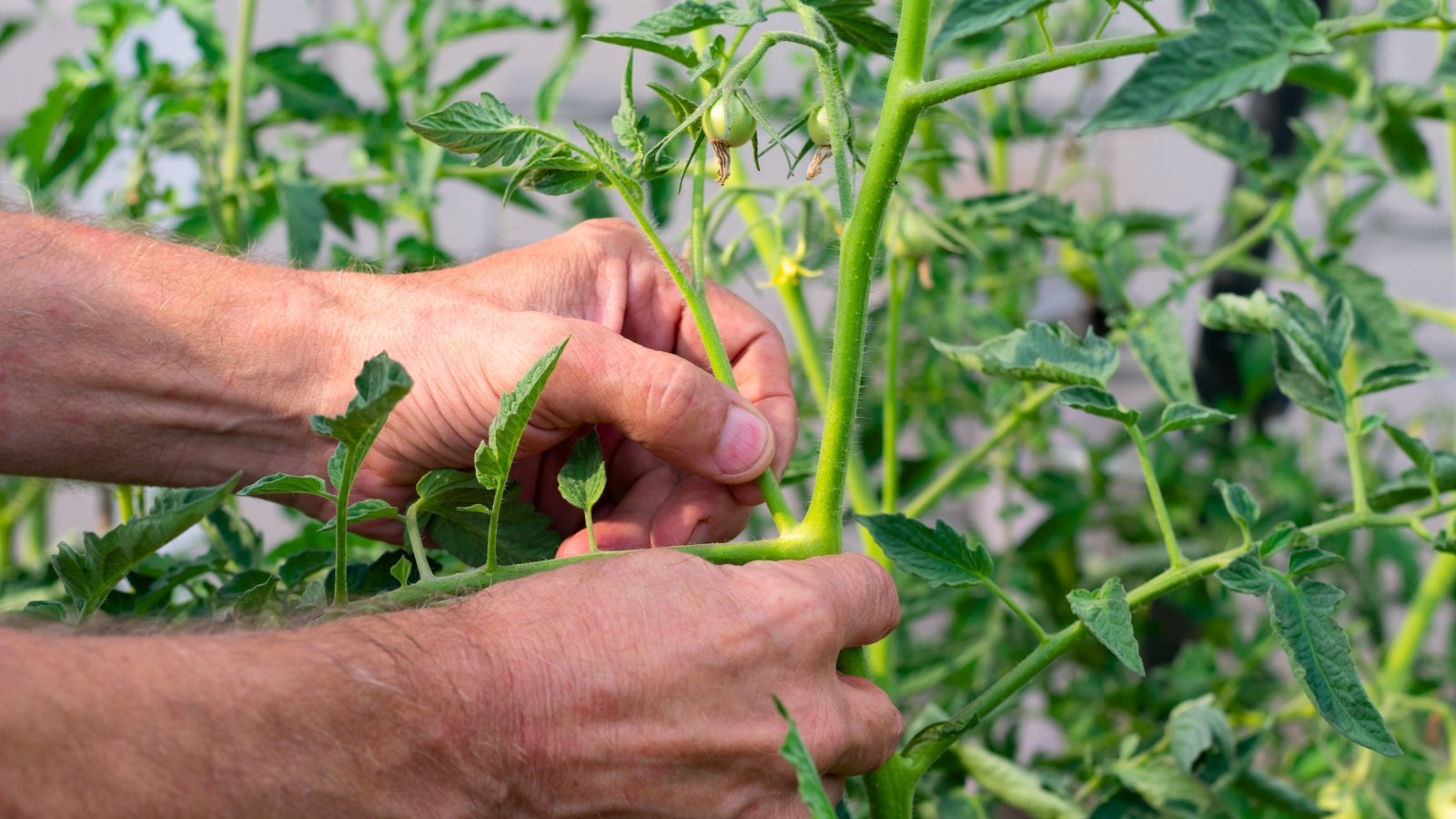
Suckers are a serious energy drain on tomatoes. These elongated side shoots grow from the most indeterminate vining varieties. They are called suckers because they suck energy and sugar away from fruit production. If left in place, every little sucker can grow into a giant leafy tomato vine. Most of us are growing tomatoes for their sweet fruits (not their green foliage), so removing suckers is crucial to keep the energy flowing where we want it.
You’ll notice suckers develop in the early stages of tomato growth within a few weeks of transplanting. As the plants mature, they’ll produce more and more suckers in an attempt to grow as big as possible. By pruning the side shoots away, you can encourage just one or two central vines. The smaller number of vines are easier to trellis and harvest from.
Suckers are easy to snap or pinch off with your fingers when small. They are located in the “elbow ditches” where leaf stems branch off from the main stalk(s). They typically grow at a 45° angle diagonally from the main vine. If the sucker gets too big to snap, use clean, sanitized shears or pruners to snip it away. You don’t want to tug or rip the stem, as this could harm the vines and cause issues with wound healing.
It’s best to remove suckers every time you spot them. Aim for a quick five-minute sweep once or twice a week in peak summer. You can easily snap suckers, harvest fruits, and train the plants on their trellis on each visit to your tomato patch.
Ensure Proper Pollination
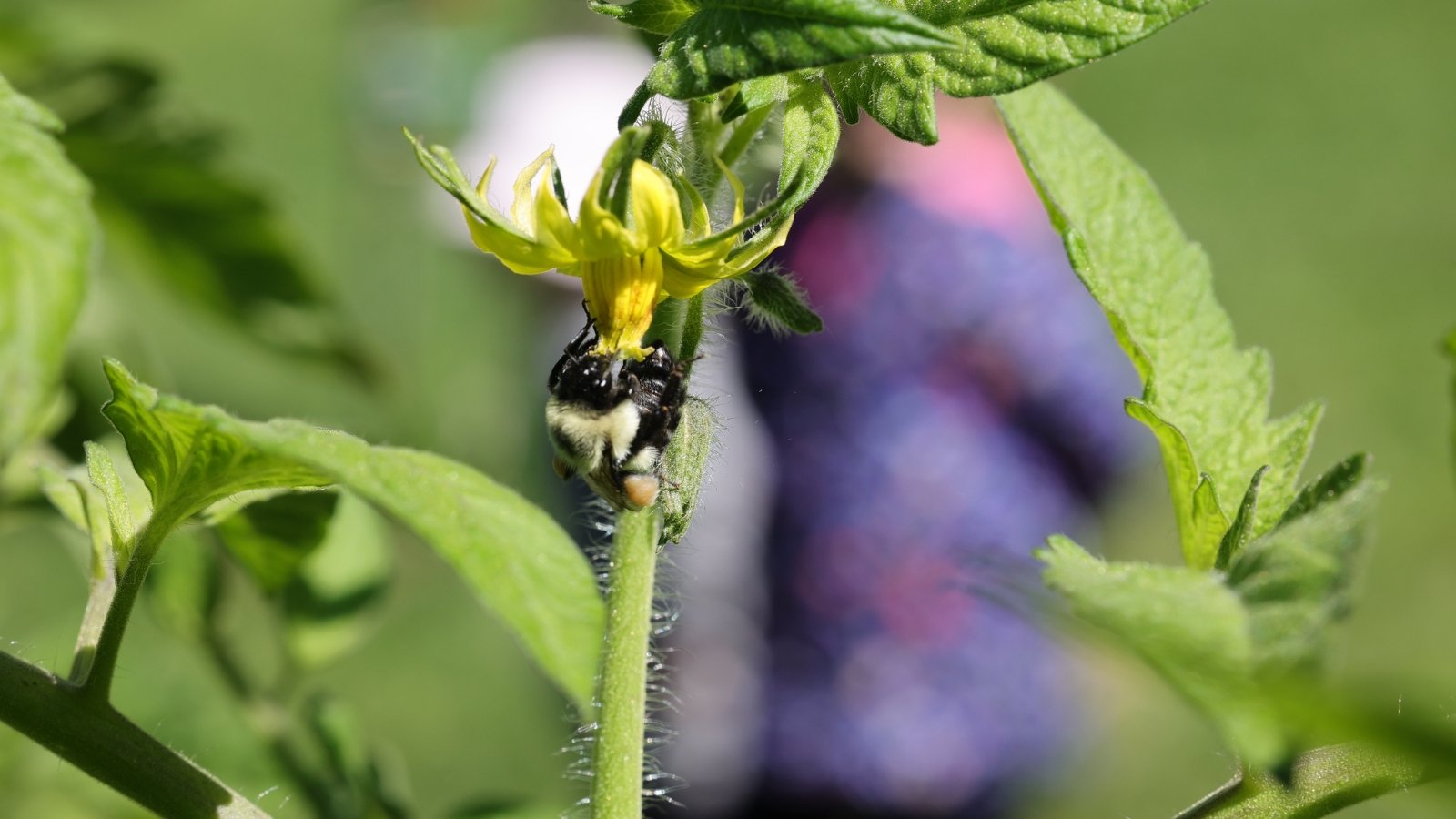
Without floral pollination, you won’t have any fruits! While many other summer crops rely on insects to pollinate their flowers, tomatoes are predominantly pollinated by wind. Bees can still be helpful, though.
Tomatoes are self-pollinating. The flowers are “perfect,” meaning they contain both male and female parts. Each flower typically fertilizes itself. Still, the pollen grains must reach the ovules inside the flowers in order to ensure big, juicy fruit.
In areas with less wind, like a greenhouse or a protected garden, pollination can be an issue. If you notice yellow blossoms falling to the ground or failing to produce fruits, you may want to give the plants a pollination boost.
Gently grab the vine and shake it around to mimic the wind. You can also use a little paintbrush to shake around inside the flowers. Some gardeners prefer an electric toothbrush, which can vibrate along the outside base of the flower to simulate wind or a buzzing bee. While smaller gardens can benefit from this, larger gardens may already have access to the wind and pollinators needed to develop robust harvests.
Eat Tomatoes at Room Temperature
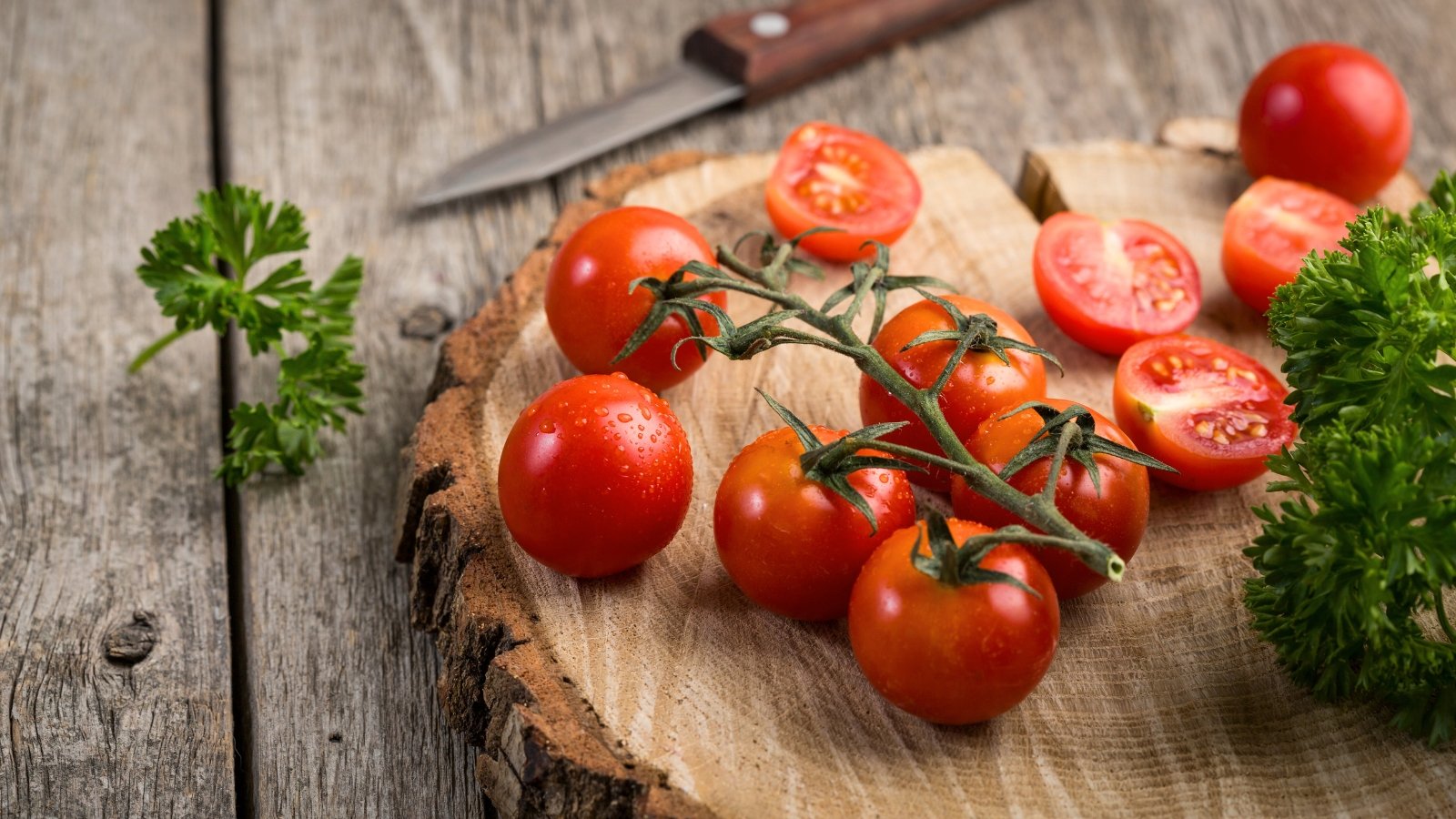
There is a big debate amongst chefs and gardeners about whether or not you should refrigerate tomatoes. It turns out that storing them in the fridge doesn’t significantly change the flavor. However, many taste trials show that eating tomatoes at room temperature can make them taste sweeter.
A new study found that tomatoes stored in the fridge for a couple of days versus those stored on the counter had the same flavor quality. The real differences in flavor were actually attributed to the tomato variety and the overall storage time.
Regardless of your choice to refrigerate, it’s best to harvest your tomatoes within a few days of eating them. If you have tomatoes sitting on the countertop and you won’t have time to prepare them, refrigerating them can prolong their edible time frame and reduce the risk of over-ripening.
Salt Your Tomatoes Before Eating
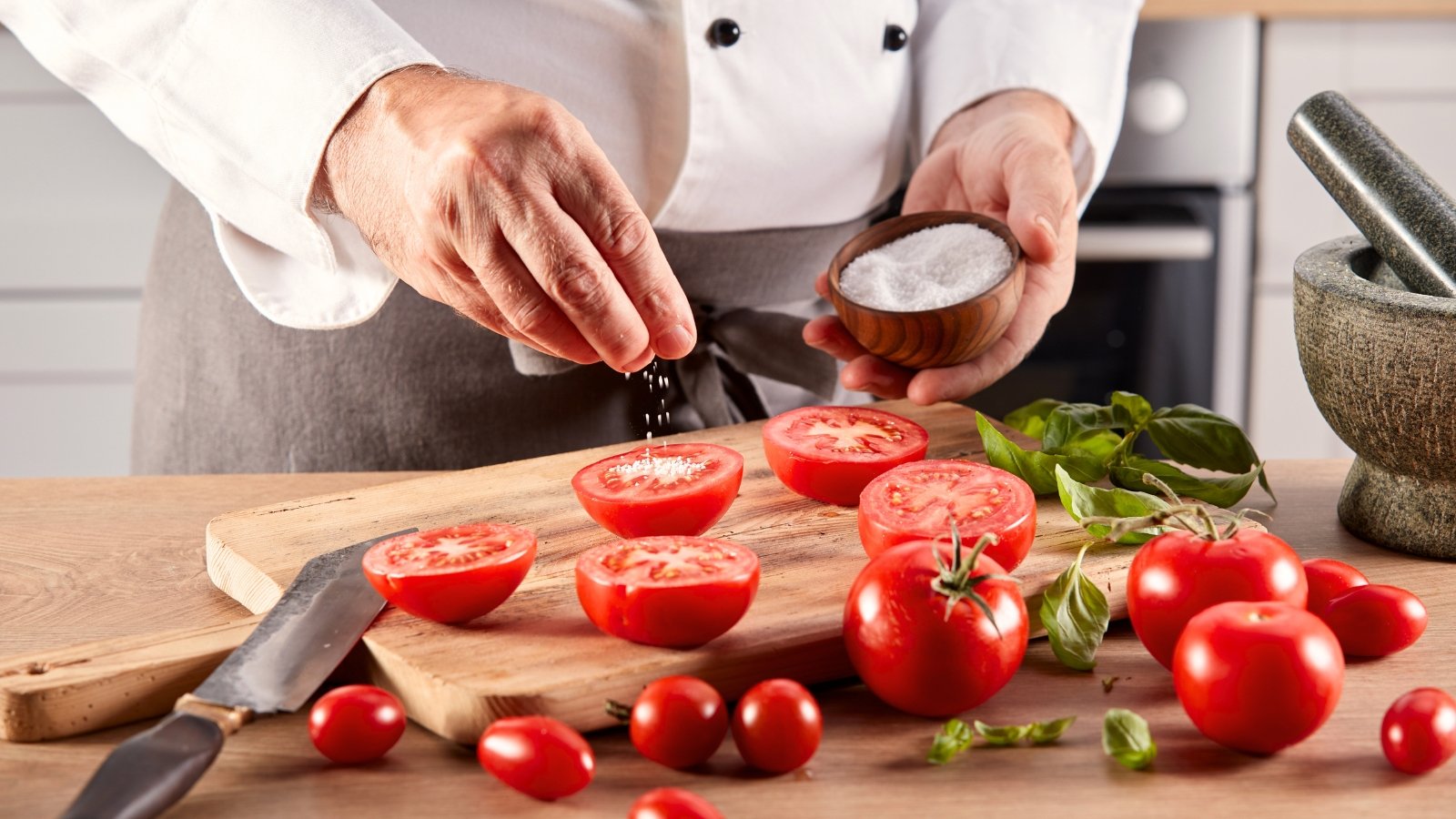
Once you’ve grown and harvested vine-ripened tomatoes, kitchen preparation can still affect their sweetness. Salting is a major recommendation from top chefs. A nice layer of quality salt brings out the best flavor in tomatoes.
It can also help improve the texture of watery heirlooms. Salt causes tomatoes to release their juices. When you slice or dice up a tomato and sprinkle it with salt, the salt draws out the water from the upper flesh. If you place the fruits in a colander or pat dry a slice a few minutes after salting, the pieces will be firmer with more concentrated flavor. The result is sweeter, more intense tomatoey goodness!
Final Thoughts
Growing tomatoes for maximum sweetness and flavor requires attention to detail. You must select the best varieties, plant them in the best soil, and harvest them at the best time. Full sunlight, consistent moisture, mulch, and regular sucker removal are helpful for enhancing productivity. Aim for a balanced organic slow-release fertilizer that is high in potassium for proper fruit ripening. Experiment with slightly reducing irrigation in the few days leading up to a big harvest, as this can concentrate sugars in the fruits.
Allow fruits to “blush” on the vine and let them fully ripen before eating. Consume tomatoes at room temperature with a sprinkle of salt to enjoy the best flavor and greatest sweetness.





